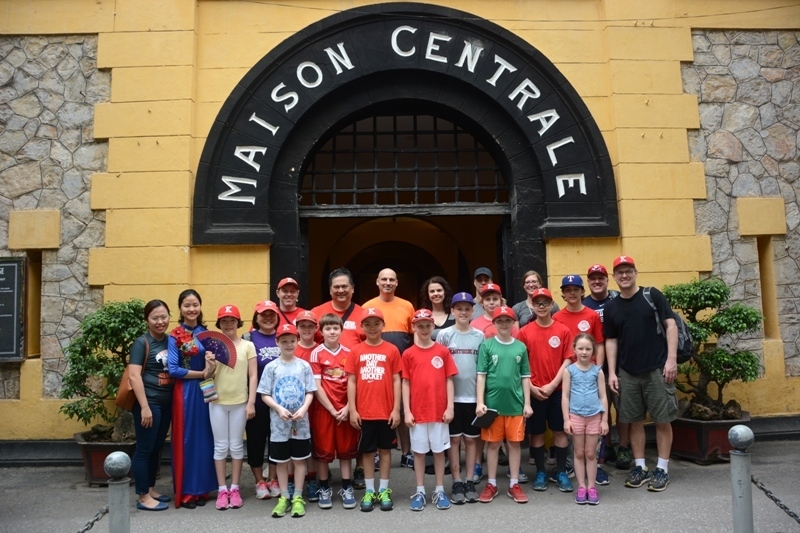
Hoa Lo Prison ( Nhà Tù Hỏa Lò)
HOA LO PRISON- NHÀ TÙ HỎA LÒ
Construction and Architecture:
- Construction:
The construction project started in 1896 and finished in 1899.
The prison was built next to the Court of Justice and Intelligence Department as the combination against the patriotic movement of the Vietnamese.
- Name:
The formal name of the prison is Maison Centrale (Central House) given the French expectation of this as the most secured and solid prison in Indochina.
The other name of the prison, in Vietnamese, is Hoa Lo:
“Hỏa” means fire
“Lò” means Kiln
Since this area used to belong to a pottery village before the prison construction, the local named the prison as Hỏa Lò as the informal memorial name of the village.
- Capacity:
Originally, the prison was designed to hold only 450 prisoners.
However, the actual number of prisoners was much higher, under the French domination
- In 1913: 615 prisoners
- In 1953: 2000 prisoners
Some detention rooms were too crowed that the weaker prisoners were requested to be taken out to avoid the choke.
- Architecture:
The so-called ‘unbreakable prison’ was constructed with extra thick bricks and tiles.
The besieging wall was built with steel bars and stone 4m high and 0.5m thick
The wall is topped with pieces of broken glass and high-voltage electric wire
Despite the varying chambers’ dimensions, all follows an identical design: tile roofs, solid walls, gray lacquered floors.
For the maximization of security, all equipment, from building material such as glass, steel, …to equipment such as doors, lockers, nails, …must be imported directly from France.
- Map:
Hoa Lo Prison’s Map in the 20th centuries
The prison was divided in to 4 sections: A, B, C and D.
Zones A and B were for inmates are being considered, criminals or prisoners in violation of prison discipline.
Zone C was for the detainment of the French prisoners or foreigners.
Zone D was the place where prisoners who were sentenced waited for the execution date.
- Famous artifacts:
The guillotine: known as the “human killer”, was brought by the French since the late 19th century.
The instrument is made of 3 parts:
- A flat wooden surface
- A cutting steel frame
- A sharp blade.
When the prisoner is executed, the headman drags the rope and the blade drops down incisively.
On execution:
The head of the prisoner fell into the underlining tank
The remaining body was transferred into the calameae basket.
Particularly, after the execution, the French even hung the prisoners’ head at public place to threaten and undermine the Vietnamese’s will.
The execution row:
Prisoners who were sentenced to be executed were detained and had to wait for the fixed date.
The execution row
They were fettered on the cement floor all day and night, and did everything in that one place.
Normally, they were detained in this row for ten months after being sentenced. However, some of them were killed right after three or four days.
The cachot:
Cachot is used to detain those who were punished for violating the rules of the prison. Cachot in Hoa Lo is “hell of hell” where the cell is cramped and dark.
Here, the prisoners are isolated, shackled all day and night and must eat, sleep, sanitate at the place.
The cachot’s custody is subject to death shortly due to edema, blurred vision, scabies for lack of proper hygiene, light and oxygen.
The iron shank:
This iron leg shank is composed of two parts:
- The upper part is made of iron
- The lower part is made of wood.
In an attempt to escape, the prisoners usually applied a layer of fat and burned coal to loosen the hole.
– Hoa Lo Prison Entrance Fee:
Ticket price is 30.000 VND/each (≈ 1.2 USD) (Discount 50% for Student with card)
– Opening hour:
Every day (including holidays or Tet, New Year Eve), from 8 am to 5 pm
– Address: 1 Hoả Lò, Trần Hưng Đạo, Hoàn Kiếm, Hà Nội
– Phone: 024 3934 2253

Hoa Lo Prison
Hoa Lo Prison, also known as Maison Centrale, is a representative of the period of Vietnamese revolutionary struggle against the French colonists. Located in the heart of Hanoi Capital and known as one of the most inhumane prisons in Vietnam with the most modern equipment at the time for the harshest punishment.
Hoa Lo prison is a symbol of the Vietnamese patriots’ indomitable will and myriad sacrifice for national independence.
The French Colonial:
This prison was built by the French colonialist on the outskirts of the city, as the central prison city of both central and southern parts of Vietnam.
It housed a variety of people, including political prisoners, patriots against the French colonial government.
In 1899, even when then construction was not completed; the French used Hỏa Lò for the capture of numerous political fighters against them.
Those years after, the prison was periodically updated with the increase in the number of chambers, the expansion in areas and the importation of up-to-date facilities.
World War II:
At the time of World War II, when the French lost, the Japanese claimed the victory and replaced the French’s position in controlling Indochina, Hỏa Lò prison was also under the Japanese regulations.
The battle between Japanese and French at the time in this area was a precious moment for the historical prison break which story still anchored until the present time.
Vietnam War (1954-1973)
As the French colonists left Hanoi as the result of the defeat at the battle of Dien Bien Phu and the 1954 Geneva Accords, Hoa Lo Prison was under the control of the Democratic Republic of Vietnam.
From 1954 to 1973, Hoa Lo prison was used for the detainment of spies from the South, the political prisoners who were against the Vietnam Communist Party and U.S solders.
Notably, the American senator John McCain and Pete Peterson, the first US Ambassador in Vietnam following the re-establishment of diplomatic ties between two countries in 1995.
The US prisoners sarcastically called Maison Centrale as “Hanoi Hilton.” As there were many US solders kept in other prison, US pilots were detained in Hoa Lo prison right in the center of the city as a way to prevent US’s aircraft from bombing Hanoi, given the two previous cruel bombs that the US dropped in 1968 and 1972.
Post-War Time:
The prison is continued to be in use after 1973 for criminal prisoners.
In 1994, the government decided to move the prison to the outskirts of Hanoi and built the Hanoi Tower for apartments and shopping mall.
Only a part of the prison remained and were preserved as the memorial of the Vietnamese patriots.
————–
Smile Travel is one of the fast growing Tour Companies in Vietnam. We are as Inbound and Outbound Tour Operator Licence No 01-1051/TCDL-GPLHQT. We specialize in tailor-making and customizing individual, Couple, family and group tours throughout Indochina destinations.
Our Tour:
Halong Cruises Tours, Vietnam Classic Tours, Hanoi Daily Tours, Danang Daily Tours, Ho Chi Minh Daily Tours, Biking and Motorbike Tours,Vietnam Beach/ Relaxing Tours,Vietnam Muslim tour in Hanoi,Vietnam Muslim tour in Danang ,Vietnam Muslim tour in Ho Chi Minh,Vietnam Eco Tours,Vietnam- Laos Tours,Vietnam- Cambodia Tours,Vietnam- Myanmar Tours,
Our Travel Services:
Tour Guide, Car/Motorbike For Rent, Visa to Vietnam, Bus Tickets, Bus Tickets, Flight Tickets, Train Tickets
--------------------------------------------------
